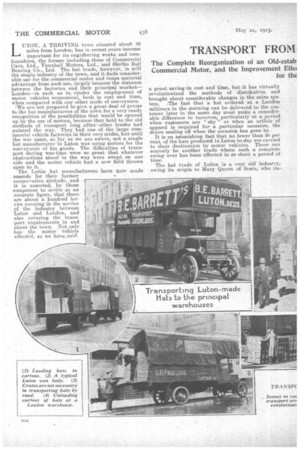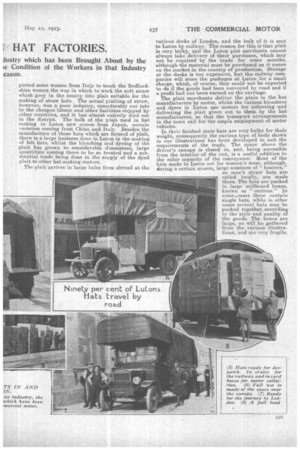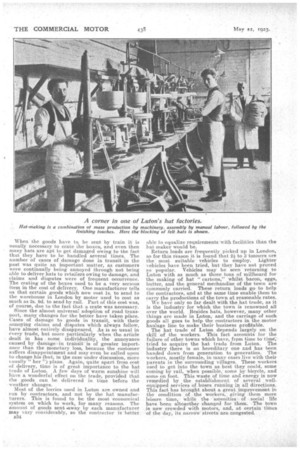TRANSPORT FROM HAT FACTORIES.
Page 18

Page 19

Page 20

If you've noticed an error in this article please click here to report it so we can fix it.
LUTON, A THRIVING town situated about 30 miles from London, has in recent years become important for its engidbering works and ironfoundries, the former includingthose of Commercial Cars, Ltd., Vauxhall Motors, Ltd., and Skefko Ball Bearing Co., Ltd. The hat trade, however, is still the staple industry of the town, and it finds considerable use for the commercial motor and reaps material advantage from such use, largely because the distance between the factories and their principal. market— London —is such as to render the employment of motor vehicles economical, both in cost and time, when compared with any other mode of conveyance. .MTe are not prepared to give a great deal of praise to the hat manufacturers of the kiwn for a very ready recognition of the possibilities that would be opened up by the use Of motors, because they held to the old methods of transportlong after-r,other trades had pointed the way. They had one of the large commercial vehicle factories in their very midst, but until the war came, so far as we are aware, not a single hat manufacturer in Luton was using motors for the conveyance of his goods. The difficulties of transport during war-time were so great that whatever obstructions stood-in the way were swept on one side and the motor vehicle had a new field thrown. open to it.
The Luton hat manufacturers, have now made
amends for their for-her conservative attitude, and it is asserted, by those competent to arrive at an accurate figure, that there are about a hundred lorries running in the service of the industry between Luton and London, and also covering the transport requirements in and about the town. Not only has the motor Vehicle effected, as we have .551d
a great, saving in cost and time, but it has virtually revolutionized the methods of distribution and brought about considerable changes in the sales system. :The fact that "a hat ordered at a London milliners in the morning can be delivered to the customer later in the same day must make a considerable difference to turnover, particularly at a yeriod when customers are " shy " or when an article of apparel is required for a particular occasion, the desire cooling off when the occasion has gone by.
, It is an astonishing fact that no fewer than 90 per cent. of the hats produced in Luton to-day are carried to their destination by motor vehicles. There can scarcely be another trade where such a complete swing over has been effected in se short a period of time.
• The hat trade of Luton is a very old industry, owing its origin to Mary Queen of Scots., who Un
ported some women from Italy to teach the Bedfordshire women the way in which to work the soft straw which grey in the county into plait suitable for the making of straw hats. The actual plaiting of straw, however, was a poor industry, considerably cut into by the cheaper labour and other facilities enjoyed by other countries, and it has almost entirely died out in the district. The bulk of the plait used in hat making in Luton now comes from Japan, certain varieties coming from China and Italy. Besides the manufacture of those hats which are formed of plait, there is a large business done in Luton in the making of felt hats, whilst the bleaching and dyeing of the plait has grown to considerabledimensions' large quantities coming there to be so treated and a substantial trade being done in the supply of the dyed plait to other hat-making centres.
The plait arrives in large bales from abroad at the various docks of London, and the bulk of it is sent to Luton by railway. The reason for this is that. plait is very bulky, and the Luton plat merchants cannot always take delivery of their purchases, which may not be required by the trade for some mouths, although the material must be purchased as it comes on the market in the country of production. Storage at the docks is too expensive, but the railway companies will store the packages at Luton for a small charge, which, of course, they could not be expected to do if the goods had been conveyed by road and if a profit had not been earned on the carriage. The plait merchants deliver the plain to the hat manufacturers by motor, whilst the various 'bleachers and dyers in Luton use motors for collecting and delivering the plait given out to them by the hat manufacturers, so that the transport arrangements in the town call for the ample employment of motor vehicles
In their finished state bats are very bulky for their weight, consequently the Curious type of body shown in our illustrations has been developed to suit the requirements of the trade. The space above the driver's canopy is closed in, and, being accessible from the interior of the van, is a useful addition to the cubic capacity of the Conveyance. Most of the hats made in Luton are for women's wear, although, during a certain season, large numbers of " boaters," as men's straw hats are calkd locally, are made -there. The hats are packed in large .millboard boxes, known as " cartons." In some,cases these contain single hats, while in other eases several hats may-be packed together, according to the style and quality of the goods. The boxes: are :large, as will be ,gathered from the various ilIustrations,.and are very fragile.
When the goods have to be sent by train it is usually necessary to crate the boxes, and even then many hats are apt to get damaged owing to the fact that they have to be handled several times. The number of cases of damage done in transit in the past was quite an important matter, as customers were continually being annoyed through not being able to deliver hats to retailers owing to damage, and claims and disputes were of frequent occurrence. The crating of the boxes used to be a very serious item in the cost of delivery. One manufacturer tells us that certain goods which now cost is. to send to the warehouse in London by motor used to cost as much as 28. 9d. to send by rail. Part of this cost was, of course, due to the fact that a crate was necessary.
Since the almost universal adoption of road transport, many changes for the better have taken place. Cases of damage to goods in transit, with their annoying claims and disputes which always follow, have almost entit•ely disappeared. As is so usual in every trade, but more particularly when tho article dealt in has , some individuality, the annoyance caused by dainag-e in tranSit is of greater importance than the monetary loss, because the customer suffers disappointment and may even be called upon to change his (hut, in: the case under discussion, more 1,sually her ") plans. Aga-in, quite apart from cost of delivery, time is of great importance to the hat trade of Luton. A few clays of warm sunshine will have a wonderful effect on the trade, provided that the _goods can be delivered in time before the weather changes.
Most of the lorries used in Luton are, owned and. Tun by contractors, and not by the hat manufacturers. This is found to be the most economical system on which to work, for many reasons. The amount of goods sent .away by each manufacturer may vary considerably, so the contractor is' better.
e34 able to equalize requirements with facilities than the hat maker would be.
Return loads are frequently picked up in London, so for this reason it is found that 2i to 3 tonners are the most suitable vehicles to employ. Lighter
A A
chides have been tried, but they have not proved so popular. Vehicles may be seen returning to Luton with as much as three tons of millboard for the making of hat "cartons," whilst bacon, eggs, butter, and the general meehandise of the town are commonly carried. These return loads go to help the contractors, and at the same time enable them to carry the productions of the town at reasonable rates.
We have only so far dealt with the hat trade, as it is the industry for which the town is renowned all over the world. Besides hats, however, many other things are made in Luton, and the carriage of such goods all goes to help the contractors in the motor haulage line to make their business profitable.
The hat trade of Luton depends largely on the skill :of the workers. This fact accounts for the failure of other towns which have, from time to tin; tried to acquire the hat trade from Luton. The industry there is an hereditary one and has been handed down from generation to generation. The workers, mostly female, in many eases live with their parents in the surrounding villages. These workers used to get into the town as best they could, some coming by rail, when possible. sonic by bicycle, and some on foot. This waste of time and energy is now remedied by the establishment of severalwellequipped services ef buses running in all directions. This fact has brought about a great improvement in the condition of the workers, giving them. more leisure •time, while the amenities' of soCial • life have been altogether changed for them. The town is now crowded with 'motors, and, at certain tithes of the -day., its narrow streets are congested.


































